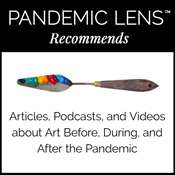PL Recommends: Week 2
By Linda Bennett | October 6, 2020
 This week’s lineup includes an article on pandemic art created by one publication’s readers (some quite impressive)…a look at how British sculptor Sir Antony Gormly and the infamous Bansky are responding to the pandemic…and a commentary on how “starving artist” has become all too literal. We also suggest an insightful and sobering podcast that examines the sustainability of museums, galleries, and physical spaces for experiencing art. And be sure to watch a remarkable video on how the way coronavirus is depicted can shape our perceptions.
This week’s lineup includes an article on pandemic art created by one publication’s readers (some quite impressive)…a look at how British sculptor Sir Antony Gormly and the infamous Bansky are responding to the pandemic…and a commentary on how “starving artist” has become all too literal. We also suggest an insightful and sobering podcast that examines the sustainability of museums, galleries, and physical spaces for experiencing art. And be sure to watch a remarkable video on how the way coronavirus is depicted can shape our perceptions.
Quote of the Week
“Bringing people together, inspiring, soothing and sharing: these are the powers of art, the importance of which has been made emphatically obvious during the COVID-19 pandemic.”
—Audrey Azoulay, Director-General of UNESCO
READS
The Best Art Created by Washington Post Readers During the Pandemic
Michael Cavna
Washington Post
There is so much creativity in this wonderful article where WP readers have expressed their hopes, sorrow and even humor through making art during our ongoing pandemic. So take a break and find yourself sitting on a “Distancing Bench” in the driveway of Kimberly Kelzer from Washington State or have a laugh with Agnes Barton–Sabo from Oregon when you see “Ode to Helen Rosner’s Roast Chicken.” (Her tools for this project include flour, water, tape, two issues of the New Yorker—and yes—paint!) Then travel “Into the Void” or the unknown post-pandemic world in diaphanous blue swirls with Dina D’Argo from Tennessee. Unlock your inner artist.
Coronavirus: How artists are depicting the lockdown
Ella Wills
BBC News
To document his time during COVID, British sculptor Sir Antony Gormly paired down his work from impressively huge monumental statues to small expressive inward-looking small figures, “manageable on his kitchen table.” Banksy expresses lockdown with macabre rats causing “mayhem” in his bathroom. His wife is not amused. While traditional ways of experiencing art in galleries and museums are very limited, if not impossible now, artists are learning to provide comfort and inspiration in new ways. Art is a balm for our troubled times.
Here’s How Artists are Creating—and Surviving—During the Covid-19 Pandemic
Irvin Zhang
News@Northeastern
One of the artists featured (Sylvia Lopez Chavez, Boston) talks about struggling to put “bread on the table,” but undaunted, she declares, that “now more than ever, I think people realize the importance of public art. It has this capacity to bring joy, to bring wonder, to bring a glimpse of hope when you’re outside during this time that is so challenging and difficult time.” She is not alone. Only 62% of artists were fully employed, while close to 100% had a precipitous drop in income, according to according to survey from Americans for the Arts. The work of two other artists (Katy Ann Gilmore, LA, and Tomislav Topic, Berlin) signifies the spirit and commitment artists bring to their work, connecting to the world even under extraordinary circumstances.
LISTEN
Three Ways Coronavirus Will Transform the Art World
Podcast: Artnet News
Listen to thoughts on the viability of museums, galleries/art festivals, and other art venues that connect us to one another and to the world from thoughtful and knowledgeable art experts. The podcast raises practical and complex issues about how these places will stay open in the future and possible adaptations that will be invented to connect to people in new ways. Here are some of the questions raised and discussed: Will solutions created during coronavirus be accepted by viewers? Will the social distancing of today influence our return to physical spaces with large groups of other people? And will online outreach be an acceptable and valued alternative when we traditionally associate the richness of our experience of art with being in the same physical space as the work? Lots of food for thought here; there is so much we don’t know about the long-term outcomes. Coronavirus changes everything.
WATCH
How Does Art Change our Perceptions of COVID-19?
Taylor McNeil
Tufts Now
McNeil invites us to check out Tufts Museum of Fine Arts professor Chantal Zakari’s engaging short video in which she presents images of the Coronavirus she has collected from all over the world. Zakari explores how different depictions of the virus and the context in which they appear can change our perceptions of coronavirus and influence its identity in our shared consciousness.
Copyright © 2020 Linda Bennett
Linda Bennett has been a museum docent for 10 years, most recently focusing on engaging Adults with Memory Loss with works of art at the University of Michigan Museum of Art. In addition she has earned two graduate degrees (Master of Science and Master of Public Health) from the University of Michigan.